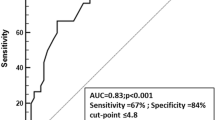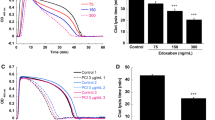Abstract
The antifibrinolytic enzyme carboxypeptidase U (CPU, TAFIa, CPB2) is an appealing target for the treatment of acute ischemic stroke (AIS). Increased insights in CPU activation and inactivation during thrombolysis (rtPA) with or without endovascular thrombectomy (EVT) are required to develop CPU inhibitors as profibrinolytic agents with optimal benefits/risks. Therefore, CPU kinetics during ischemic stroke treatment were evaluated. AIS patients with documented cerebral artery occlusion receiving rtPA (N = 20) or rtPA + EVT (N = 16) were included. CPU activation during thrombolysis was measured by an ultrasensitive HPLC-based CPU activity method and by an ELISA measuring both CPU and inactivated CPU (CPU + CPUi). Intravenous blood samples were collected at admission and throughout the first 24 h. Additional in situ blood samples were collected in the rtPA + EVT cohort proximal from the thrombus. The NIHSS score was determined at baseline and 24 h. CPU activity and CPU + CPUi levels increased upon rtPA administration and reached peak values at the end of thrombolysis (1 h). High inter-individual variability was observed in both groups. CPU activity decreased rapidly within 3 h, while CPU + CPUi levels were still elevated at 7 h. CPU activity or CPU + CPUi levels were similar in in situ and peripheral samples. No correlation between CPU or CPU + CPUi and NIHSS or thrombus localization was found. The CPU system was rapidly activated and deactivated following thrombolysis and thrombectomy in stroke patients, suggesting that a CPU inhibitor would have to be administered during rtPA infusion and over the next few hours. The high CPU generation variability suggests that some patients may not respond to the treatment. EudraCT number 2017-002760-41.





Similar content being viewed by others
Data Availability
Anonymized patient-level, study-level clinical trial data (including clinical study report) and study protocol, underlying the results reported in this article will be shared in agreement with the Servier Data Sharing Policy available at https://clinicaltrials.servier.com/data-request-portal/.
Code Availability
Not applicable.
References
Donkor ES. Stroke in the 21st century: a snapshot of the burden, epidemiology, and quality of life. Stroke Res Treat. Hindawi; 2018;2018.
Rha JH, Saver JL. The impact of recanalization on ischemic stroke outcome: a meta-analysis. Stroke. 2007;38:967–73.
Coutts SB, Berge E, Campbell BCV, Muir KW, Parsons MW. Tenecteplase for the treatment of acute ischemic stroke: a review of completed and ongoing randomized controlled trials. Int J Stroke. 2018;13:885–92.
Bhatia R, Hill MD, Shobha N, Menon B, Bal S, Kochar P, et al. Low rates of acute recanalization with intravenous recombinant tissue plasminogen activator in ischemic stroke: real-world experience and a call for action. Stroke. 2010;41:2254–8.
Christou I, Felberg RA, Demchuk AM, Scott Burgin W, Malkoff M, Grotta JC, et al. Intravenous tissue plasminogen activator and flow improvement in acute ischemic stroke patients with internal carotid artery occlusion. J Neuroimaging. 2002;12:119–23.
Zangerle A, Kiechl S, Spiegel M, Furtner M, Knoflach M, Werner P, et al. Recanalization after thrombolysis in stroke patients: predictors and prognostic implications. Neurology. 2007;68:39–44.
Hasan TF, Todnem N, Gopal N, Miller DA, Sandhu SS, Huang JF, et al. Endovascular thrombectomy for acute ischemic stroke. Curr Cardiol Rep. Current Cardiology Reports; 2019;21.
Wollenweber FA, Tiedt S, Alegiani A, Alber B, Bangard C, Berrouschot J, et al. Functional outcome following stroke thrombectomy in clinical practice. Stroke. 2019;50:2500–6.
Bajzar L, Morser J, Nesheim M. TAFI, or plasma procarboxypeptidase B, couples the coagulation and fibrinolytic cascades through the thrombin-thrombomodulin complex. J Biol Chem. 1996;271:16603–8.
Claesen K, Mertens JC, Leenaerts D, Hendriks D. Carboxypeptidase U (CPU, TAFIa, CPB2) in thromboembolic disease: what do we know three decades after its discovery? Int J Mol Sci. 2021;22:883.
Foley JH, Kim PY, Mutch NJ, Gils A. Insights into thrombin activatable fibrinolysis inhibitor function and regulation. J Thromb Haemost. 2013;11:306–15.
Brouns R, Heylen E, Sheorajpanday R, Willemse JL, Kunnen J, De Surgeloose D, et al. Carboxypeptidase U (TAFIa) decreases the efficacy of thrombolytic therapy in ischemic stroke patients. Clin Neurol Neurosurg. 2009;111:165–70.
Brouns R, Heylen E, Willemse JL, Sheorajpanday R, De Surgeloose D, Verkerk R, et al. The decrease in procarboxypeptidase U (TAFI) concentration in acute ischemic stroke correlates with stroke severity, evolution and outcome. J Thromb Haemost. 2010;8:75–80.
Fernandez-Cadenas I, Alvarez-Sabin J, Ribo M, Rubiera M, Mendioroz M, Molina C-A, et al. Influence of thrombin-activatable fibrinolysis inhibitor and plasminogen activator inhibitor-1 gene polymorphisms on tissue-type plasminogen activator-induced recanalization in ischemic stroke patients. J Thromb Haemost. 2007;5:1862–8.
Alessi M-C, Gaudin C, Grosjean P, Martin V, Timsit S, Mahagne M-H, et al. Changes in activated thrombin-activatable fibrinolysis inhibitor levels following thrombolytic therapy in ischemic stroke patients correlate with clinical outcome. Cerebrovasc Dis. 2016;42:404–14.
Martí-Fàbregas J, Borrell M, Cocho D, Martínez-Ramírez S, Martínez-Corral M, Fontcuberta J, et al. Change in hemostatic markers after recombinant tissue-type plasminogen activator is not associated with the chance of recanalization. Stroke. 2008;39:234–6.
Eriksson H, Sandset PM, Jensen E, Wall U, Andersson M, Nerme V, et al. CPU inhibition with AZD9684: profibrinolytic effects in acute pulmonary embolism patients [Abstract]. J Thromb Haemost. 2007;5:P-S-367.
Zhou J, Limsakun T, Yin O, Warren V, Zamora C, Atiee G, et al. First-in-human study to assess the safety, pharmacokinetics, and pharmacodynamics of an oral formulation of DS-1040, an inhibitor of the activated form of thrombin-activatable fibrinolysis inhibitor, in healthy subjects. J Clin Pharmacol. 2019;59:1669–77.
Zhou J, Kochan J, Yin O, Warren V, Zamora C, Atiee G, et al. A first-in-human study of DS-1040, an inhibitor of the activated form of thrombin-activatable fibrinolysis inhibitor, in healthy subjects. J Thromb Haemost. 2017;15:961–71.
Limsakun T, Dishy V, Mendell J, Pizzagalli F, Pav J, Kochan J, et al. Safety and pharmacokinetics of DS-1040 drug-drug interactions with aspirin, clopidogrel, and enoxaparin. J Clin Pharmacol. 2020;60:691–701.
Petit Dop F, Latreille M, Guicherd L, Mertens J., Claesen K, Hendriks D, et al. Favourable safety profile of S62798, a potent TAFIa (activated thrombin-activatable fibrinolysis inhibitor) inhibitor, in first-in-man study in healthy subjects [Abstract]. Eur Heart J. 2020;41.
Mertens JC, Leenaerts D, Yperzeele L, Sim Y, Van Der Veken P, Hendriks D. Comparison and characterization of two assays (TAFIa/ai ELISA vs. activity based selective CPU assay) for the monitoring of carboxypeptidase U (CPU, TAFIa, CPB2) levels in patients. Res Pract Thromb Haemost. 2017;1:607.
Heylen E, Van Goethem S, Augustyns K, Hendriks D. Measurement of carboxypeptidase U (active thrombin-activatable fibrinolysis inhibitor) in plasma: challenges overcome by a novel selective assay. Anal Biochem. 2010;403:114–6.
Ladenvall C, Gils A, Jood K, Blomstrand C, Declerck PJ, Jern C. Thrombin activatable fibrinolysis inhibitor activation peptide shows association with all major subtypes of ischemic stroke and with TAFI gene variation. Arterioscler Thromb Vasc Biol. 2007;27:955–62.
Pedersen A, Redfors P, Lundberg L, Gils A, Declerck PJ, Nilsson S, et al. Haemostatic biomarkers are associated with long-term recurrent vascular events after ischaemic stroke. Thromb Haemost. 2016;116:537–43.
Willemse JL, Brouns R, Heylen E, De Deyn PP, Hendriks DF. Carboxypeptidase U activity is induced in vivo in ischemic stroke patients receiving thrombolytic therapy. J Thromb Haemost. 2008;6:200–2.
Powers WJ, Rabinstein AA, Ackerson T, Adeoye OM, Bambakidis NC, Becker K, et al. 2018 Guidelines for the early management of patients with acute ischemic stroke. Stroke. 2018;49:e46-110.
Mertens JC, Claesen K, Leenaerts D, Sim Y, Lambeir A-M, Hendriks D. Inhibition of the procarboxypeptidase U (proCPU, TAFI, proCPB2) system due to hemolysis. J Thromb Haemost. 2019;17:878–84.
Leenaerts D, Bosmans JM, van der Veken P, Sim Y, Lambeir AM, Hendriks D. Plasma levels of carboxypeptidase U (CPU, CPB2 or TAFIa) are elevated in patients with acute myocardial infarction. J Thromb Haemost. 2015;13:2227–32.
Leenaerts D, Aernouts J, Van Der Veken P, Sim Y, Lambeir A, Hendriks D. Plasma carboxypeptidase U (CPU, CPB2, TAFIa) generation during in vitro clot lysis and its interplay between coagulation and fibrinolysis. Thromb Haemost. 2017;117:1498–508.
Wu C, Kim PY, Manuel R, Seto M, Whitlow M, Nagashima M, et al. The roles of selected arginine and lysine residues of TAFI (Pro-CPU) in its activation to TAFIa by the thrombin-thrombomodulin complex. J Biol Chem. 2009;284:7059–67.
Kim PYG, Kim PY, Hoogendorn H, Giles AR, Nesheim ME. Activated thrombin-activatable fibrinolysis inhibitor is generated in vivo at levels that can substantially affect fibrinolysis in chimpanzees in response to thrombin generation. J Thromb Haemost. 2008;6:1600–2.
Chetaille P, Alessi MC, Kouassi D, Morange PE, Juhan-Vague I. Plasma TAFI antigen variations in healthy subjects. Thromb Haemost. 2000;83:902–5.
Stanne TM, Olsson M, Lorentzen E, Pedersen A, Gummesson A, Gils A, et al. A genome-wide study of common and rare genetic variants associated with circulating thrombin activatable fibrinolysis inhibitor. Thromb Haemost. 2018;118:298–308.
Schneider M, Boffa M, Stewart R, Rahman M, Koschinsky M, Nesheim M. Two naturally occurring variants of TAFI (Thr-325 and Ile-325) differ substantially with respect to thermal stability and antifibrinolytic activity of the enzyme. J Biol Chem. 2002;277:1021–30.
Leurs J, Nerme V, Sim Y, Hendriks D. Carboxypeptidase U prevents lysis from proceeding into the propagation phase through a threshold-dependent mechanism. J Thromb Haemost. 2004;2:416–23.
Walker JB, Bajzar L. The intrinsic threshold of the fibrinolytic system is modulated by basic carboxypeptidases, but the magnitude of the antifibrinolytic effect of activated thrombin-activable fibrinolysis inhibitor is masked by its instability. J Biol Chem. 2004;279:27896–904.
Daiichi Sankyo. Study to assess the safety, pharmacokinetics, and pharmacodynamics of DS-1040b in subjects with acute ischemic stroke. [Internet]. ClinicalTrials.gov. [cited 2021 May 7]. Available from: https://clinicaltrials.gov/ct2/show/NCT02586233. Accessed 9 September 2020
Acknowledgements
The authors thank Y. Sim and L. Saudemont for their excellent technical assistance.
Funding
The study was funded by the Institut de Recherches Internationales Servier (IRIS, Paris, France). J.M. was a research fellow of the Research Foundation Flanders during the conduct of the study (grant: 1137719 N).
Author information
Authors and Affiliations
Contributions
Methodology: V.B.G., D.H., B.T., C.M., J.M.; formal analysis: J.M., V.B.G.; writing—original draft preparation: J.M., V.B.G., B.T.; writing—review and editing: all authors.
Corresponding author
Ethics declarations
Ethics Approval
The study was conducted according to the Declaration of Helsinki revised in Fortaleza and followed the Good Clinical Practices. Ethical approval was obtained from the respective ethics committees of the different centers and the study was approved by the competent authorities.
Consent to Participate
All patients or their legal representatives gave their informed consent before participating in the trial.
Consent for Publication
Not applicable.
Conflicts of Interest
VBG and BT are employees of IRIS. DH received consultant honoraria from IRIS.
Additional information
Publisher's Note
Springer Nature remains neutral with regard to jurisdictional claims in published maps and institutional affiliations.
Supplementary Information
Below is the link to the electronic supplementary material.
Rights and permissions
About this article
Cite this article
Mertens, J.C., Blanc-Guillemaud, V., Claesen, K. et al. Carboxypeptidase U (TAFIa) Is Rapidly Activated and Deactivated Following Thrombolysis and Thrombectomy in Stroke Patients. Transl. Stroke Res. 13, 959–969 (2022). https://doi.org/10.1007/s12975-021-00962-w
Received:
Revised:
Accepted:
Published:
Issue Date:
DOI: https://doi.org/10.1007/s12975-021-00962-w




